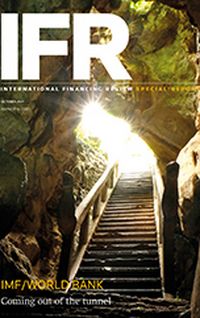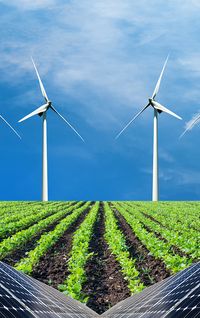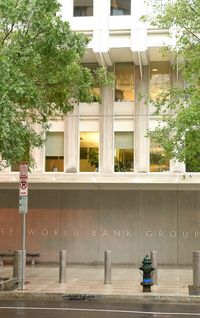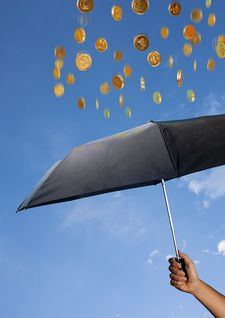Bangladesh has enjoyed one of the world's fastest growing economies for the last decade and weathered the Covid-19 storm well compared to its regional peers but faces a huge issue in coming decades – rising sea levels.
Bangladesh's economy jumped by 3.78% in 2020 and is expected to surge by 5% this year and 7.4% next, according to the International Monetary Fund.
It was one of the few countries to expand during the Covid-19 crisis last year. In comparison, India – its giant neighbour – saw its economy nosedive by almost 8%, although it is expected to rebound by 12.5% this year.
Bangladesh had one of the fastest annual economic growth rates on the planet – at 7.36% – between 2015 and 2019 and the nation has been so successful at reducing poverty that economists refer to it as a 'development miracle'.
With a population of 166 million people, the Asian country is forecast to have a US$352bn economy this year, compared with only US$195bn in 2015. Annual income per head has soared from US$1,248 in 2015 to an estimated US$2,122 this year, according to the IMF.
Bangladesh – which has been led by prime minister Sheikh Hasina since 2009 – reached lower-middle-income status in 2015 and is on track to graduate from the United Nations’ Least Developed Countries list in 2026, if not sooner. The poverty level declined from 44% in 1991 to 15% in 2016, based on the international poverty line of US$1.90 a day (using the 2011 purchasing power parity exchange rate), according to the World Bank.
In 1993, only one in 500 Bangladeshis had access to a telephone, while today the country has more than 56 million mobile phone subscribers, underscoring just how profoundly the country has developed in one generation.
The government's vision for the year 2041 is to have eliminated extreme poverty by that year; it wants to secure upper middle-income country status by 2031 and to achieve high-income country status by 2041.
The nation has some solid economic fundamentals but two big issues stand out: a fragile banking system with a high level of non-performing loans and a rising sea level that means the country could lose 11% of its land by 2050.
"Like all other economies across the globe, Bangladesh was impacted by the Covid-19 pandemic, but bounced back quickly and had 5.4% year-on-year economic growth during the fiscal year [July 2020 to June 2021]," said Joydeep Datta Gupta, a board member of Deloitte Bangladesh.
"The stable political environment has led to policy continuity and resulted in robust economic growth in the last couple of decades. This has also led to developmental work related to poverty alleviation, resulting in improved per capita income, life expectancy, access to electricity and digital service inclusion."
Bangladesh had lost 26,931 people to Covid-19 by September 13 this year. The total number of cases has been more than 1.53 million. Officially recorded infections peaked in July 2020 and declined gradually in subsequent months, only to peak again in July 2021. However, active cases and deaths had dropped significantly by September this year.
A national lockdown from March to May 2020 resulted in severe supply-side disruptions across the economy. Movement restrictions were gradually lifted from June last year and transit and workplace movement patterns had returned to pre-pandemic levels by that October.
The government launched an effective and timely stimulus in response to the crisis in the form of 23 separate packages valued at a total of US$14bn – or 4.4% of GDP – which helped support all business sectors (including cottage, micro, small and medium enterprises or CMSMEs).
Industries such as agriculture, pharmaceuticals and food production were able to continue operating during the pandemic. In April 2020, Bangladesh Bank (BB), the central bank, introduced a stimulus package valued at Tk400bn (US$4.69bn) for large industries and service companies to cushion the pandemic's impact. Borrowers had to pay interest at 4.5% – compared with 9% normally. It also announced a further stimulus package valued at Tk200bn for CMSMEs for the same reasons.
Outside help
Multilateral agencies have provided considerable support to Bangladesh to help it meet its funding requirements, including its balance of payments and other fiscal needs.
In 2020, the IMF approved US$732m in emergency assistance to the country under its Rapid Credit Facility and its Rapid Financing Instrument. The fund also provided Special Drawing Rights to the country's central bank to the tune of US$1.45bn in August 2021 to help ease the nation’s funding issues stemming from stalled payments during the pandemic.
The Asian Development Bank and the World Bank have also provided financial aid to the country, so that it could procure further vaccine doses to prevent disruptions to the vaccination rollout process. The ADB lent it around US$940m, while the World Bank provided a loan to the tune of US$500m for this purpose.
Since the vaccination rollout started in January, around 12% of the adult population have received their first dose, while 7% have been fully vaccinated. The speed of vaccination picked up in August and September as the availability of doses improved. The government expects to inoculate the entire adult population by June 2022.
"India had a terrible pandemic," said Gareth Leather, a senior economist in the emerging Asia team at Capital Economics, a London-based economic consultancy. "Its initial lockdown was severe and long. On the other hand, the pandemic's economic impact on Bangladesh has not been so great, as the lockdown there was not so severe and did not last as long. Bangladesh's fiscal stimulus was also broader than India's.
"The country has had a very successful economy during the past few years; however, it remains very poor in terms of income per head. It has had a lot of what economists call 'catch-up potential' – it has managed to expand very rapidly by copying what more developed economies have done."
The ADB expects the country to expand by 7.2% during the 2021–2022 fiscal year (which runs from July to June) and forecasts inflation to remain close to BB’s 5.5% target. The fiscal deficit is projected to remain at 6% of GDP.
Bangladesh's economic growth in large part continues to be driven by exports and continuing remittance inflows (the latter amounts to 6.6% of GDP). Its exports have recorded an annual average growth rate of around 11% since 2001.
It exported US$40.5bn in the 2018–2019 fiscal year, but that plummeted to US$33.7bn in FY 2019–2020 – a 16.8% drop – owing to the slowdown in global trade flows caused by the pandemic, according to local media reports. However, exports bounced back to US$38.75bn during FY 2020–2021 and the government has set a target of US$51bn for FY 2021–2022.
The country earned US$1.94bn more in apparel exports than Vietnam, one of its main competitor nations, in the first seven months of this year – US$18.8bn versus US$16.86bn.
During the past 40 years, Bangladesh has relied heavily on ready-made garments (RMG) for fuelling its exports growth (they account for about 84% of its merchandise exports). This industry has around 4,000 factories, employing four million workers. Its export destinations are also highly concentrated to the European Union – where it currently enjoys duty-free access – and the United States (where it no longer enjoys such access).
The export growth has been made possible by an ample supply of cheap labour as well as the duty-free access to its major markets. The nation has one of the lowest wage rates in the world, which undoubtedly has helped to stimulate the RMG industry (the minimum wage is Tk8,000 per month – equivalent to US$94, or about half that of Cambodia or Indonesia, other countries with which it competes).
During the past couple of decades, Bangladesh has mostly focused on a narrow range of relatively low-value-added RMG products and has not managed to diversify its economy. According to the World Bank's Human Capital Index for 2020, Bangladesh scored 0.46, a similar level to Zimbabwe and Guatemala. India scored slightly better at 0.49.
The country also has a cumbersome business environment – in 2020, it ranked 168th out of 190 countries on the World Bank's Ease of Doing Business Index. Infrastructural deficits cause long delays in the movement of goods to and from the ports. It is also an energy-deficit country, which could seriously hinder its effort to achieve rapid industrialisation to diversify its manufacturing base in coming decades.
These issues mean that the country has not been successful in attracting foreign direct investment, which has averaged only 1% of GDP over the last two decades.
"The external sector last year was stronger than expected," said Jayendu De, the IMF's resident representative to Bangladesh.
"Exports started to pick up again in July last year and did very well in the August to September period. They slowed down again in November but have started to rise again more recently. Remittances have also outperformed expectations. The government’s 2% cash incentive on remittances provides a 2% bonus on money sent back from abroad. Furthermore, many Bangladeshis lost their jobs in the Middle East last year and returned home. They sent remittances to the country before coming back."
However, economists say that the recent surge in official remittance inflows is unlikely to last if – as seems likely – migrant workers start to return to the Middle East this year.
Changing climate
Bangladesh is facing a major long-term crisis stemming from climate change. Around 28% of the population lives on the coast and a large number of people are being displaced by tidal flooding caused by rising sea levels.
By 2050 – with a projected 50cm rise in sea levels – the country could lose up to 11% of its land, affecting an estimated 15 million people living in its low-lying coastal region, according to the Environmental Justice Foundation, a London-based non-governmental organisation.
The process of salinisation has been exacerbated by rising sea levels as well. Coastal drinking water supplies have been contaminated with salt, leaving the 33 million people who rely on the water vulnerable to health problems, including pre-eclampsia during pregnancy, acute respiratory infections and skin diseases.
Agriculture – the mainstay of the Bangladeshi economy – is also badly affected and crops damaged by rising salinity are at risk from the resulting soil degradation.
"Bangladesh has undergone an economic miracle," said Enamul Hafiz Latifee, an economist and joint secretary at the Bangladesh Association of Software and Information Services.
"Its economy has expanded 57-fold since 1972. However, all that progress is at risk from climate change. The country is suffering from rising sea levels and increasing salinity in coastal areas. Furthermore, neighbouring countries have started to place dams on rivers flowing into Bangladesh, which is reducing the country's access to fresh water."
Furthermore, the country faces systemic risks to its banking system, which the financial authorities have been slow to tackle. The share of non-performing loans jumped to 8.18% of the total outstanding loans in the first half of this year from 7.66% on December 31 last year, according to BB.
However, the distressed debt situation is likely to be far worse than the NPL ratio implies because of the high proportion of rescheduled and restructured advances that are not included in the NPLs. Loans that have been rescheduled at least once account for 14.4% of the banking sector's total outstanding. The rescheduled loan ratio – at 30% – in the industrial sector was the worst among all business sectors last year. Meanwhile, banking clients in the garment industry rescheduled 20.4% of their loans last year.
Commercial banks have also become more risk-averse, on the back of a cap on lending rates and the rising NPL ratio. Year-on-year private sector credit growth plunged from a high of 13.3% in December 2018 to just 8.4% in June this year, according to Deloitte. Private commercial banks experienced a decline in profitability as their return on assets plunged from 0.8% in 2019 to 0.6% in 2020 and their return on equity fell from 11.2% to 8.5%.
"The country's financial authorities are well aware of the NPL issue," said the IMF's De. "The authorities are now focused on tackling Covid-19. The role of state-owned commercial banks should be reassessed, by perhaps turning them into development banks."
Modern, large-group microfinance was invented in the country. In 1976, Professor Muhammad Yunus, a Bangladeshi social entrepreneur, decided to help the poor – in particular women – to access credit by founding the country’s first major microfinance institution (MFI), called Grameen Bank. Microcredit lifted 10 million Bangladeshis out of poverty between 1990 and 2008, according to a report by US-based Microcredit Summit Campaign. However, many poor people took loans from multiple MFIs and became overly indebted.
Bangladesh has also started to attract businesses from other parts of Asia. Local media reports that up to 40 Japanese-owned businesses from mainland China and around 20 South Korean enterprises mostly based in Myanmar have shifted or are in the process of relocating their operations to Bangladesh. They are attracted by its lower overhead costs, a trained workforce, good connectivity and political stability.
"The government has taken several measures to improve the investment climate through policy support and building infrastructure, such as setting up special economic zones and adopting a public private partnership model," said Deloitte's Datta Gupta.
"The key sectors that are attracting investments both from domestic and foreign investors are RMG, agri-industry and frozen food, pharmaceuticals, light engineering and low-cost electronics. The sectors which have the potential for growth and hence investments are: ceramics, natural gas-based industries like petrochemicals and agrochemicals, and clean energy."
Its special economic zones have received investment proposals valued at US$27.07bn from a total of 210 investors, including FDI, to the tune of US$1.6bn, according to Deloitte. Currently, 76 projects are scheduled to be implemented under the PPP model and investments valued at US$27.76bn have been proposed.
Information and communications technology (ICT) has been identified by the government as a 'prospective sector', which has a large domestic market valued at US$1.54bn. Digitalisation is gathering pace in the government and the telecom, banking, finance, pharmaceutical, and garment and textile sectors.
Currently, there are more than 4,500 software and information technology-enabled services (ITES) companies, employing more than 300,000 local people with annual exports of US$1bn. Its telecommunications sector is the fifth largest in the Asia-Pacific region. A USAID report forecasts that the revenue from that industry could grow by 34% during the next five years to US$5.08bn from US$3.8bn in 2019. Light engineering, clean energy, medical and personal protective equipment are also being projected as emerging sectors.
"The ICT sector is the new frontier for Bangladesh, making it the second largest IT/ITES outsourcing destination in the world," said Latifee.
Bangladesh's tech start-up ecosystem is still at a nascent stage but there are now more than 1,000 active start-ups employing up to 1.5 million people, according to Deloitte. Start-ups in educational technology, food delivery services, grocery shopping, ride-sharing and fintech are spawning rapidly. Foreign investors have backed fintech, logistics and mobility sectors to the tune of US$300m during the last four years.
Agriculture remains an incredibly important industry. Almost 87% of the rural population obtains at least some income from it, and the country must take advantage of this significant sector.
"The government – realising the potential of agriculture – has included it in the stimulus package," said Tapash Chandra Paul, chief financial officer at Mercantile Bank. "Our prime minister has already declared to cultivate every piece of unutilised land for ensuring food security in the future."
The country's reform priorities must include a diversification of exports beyond the RMG sector, deepening the financial sector, improving urbanisation, and strengthening public governance, according to the World Bank.
"Addressing infrastructure gaps would accelerate growth and reduce spatial disparities in opportunities across regions and within cities," it said. "Human capital development remains a priority as well. While Bangladesh’s ranking on the Human Capital Index is higher than the South Asian average, it is below the levels observed in comparator countries."
However, Bangladesh could become a victim of its own success during the next few years. It faces a 'graduation storm' if it advances to become a lower middle-income country, as it could lose many of the preferential treatments and duty and quota-free facilities that it enjoys by being on the UN's Least Developed Country list. Economists expect the country to be able to adapt to these changes in the long term.
Bangladesh has witnessed impressive economic growth during the past two decades and has lifted many millions of people out of poverty. However, the government must do a lot more to tackle the non-performing loan crisis. Rising sea levels are a massive long-term issue for the country, which it will probably require international help to deal with.
To see the digital version of this report, please click here
To purchase printed copies or a PDF of this report, please email gloria.balbastro@lseg.com





























